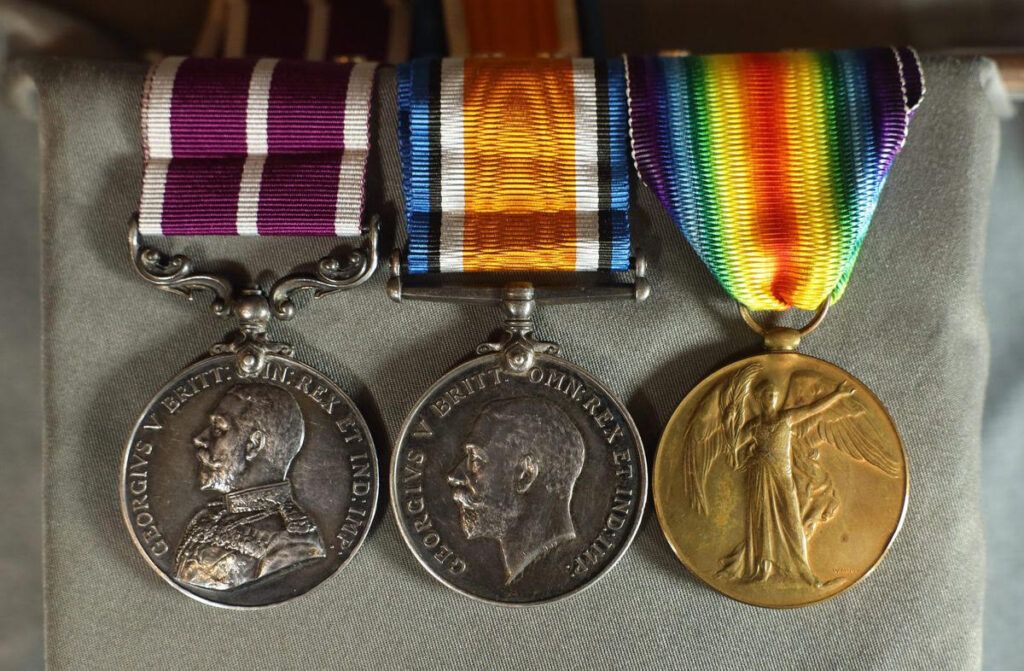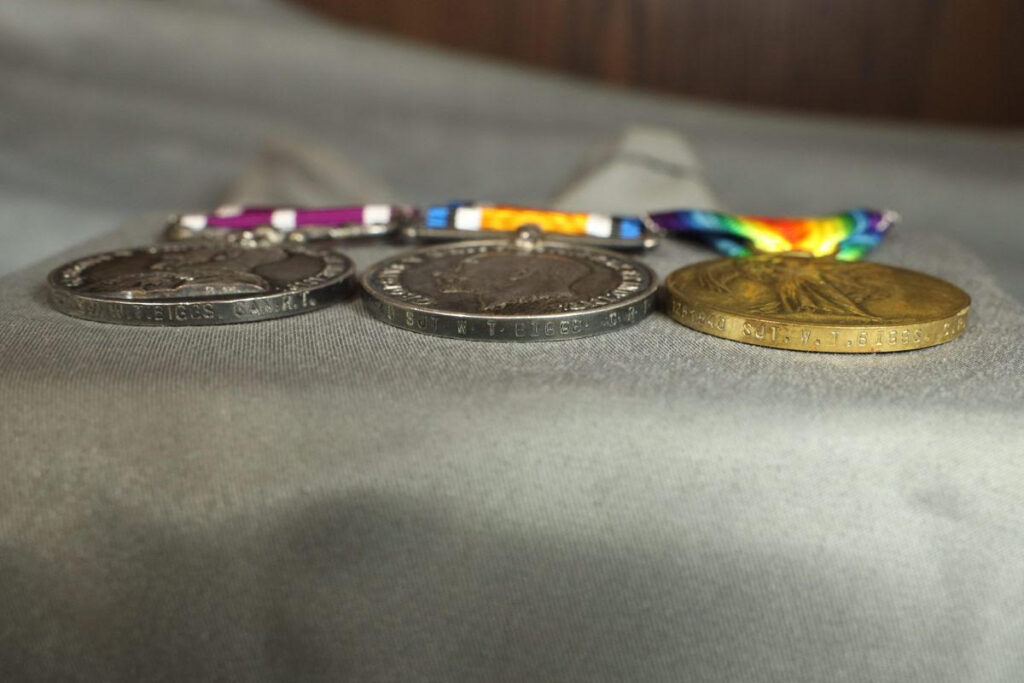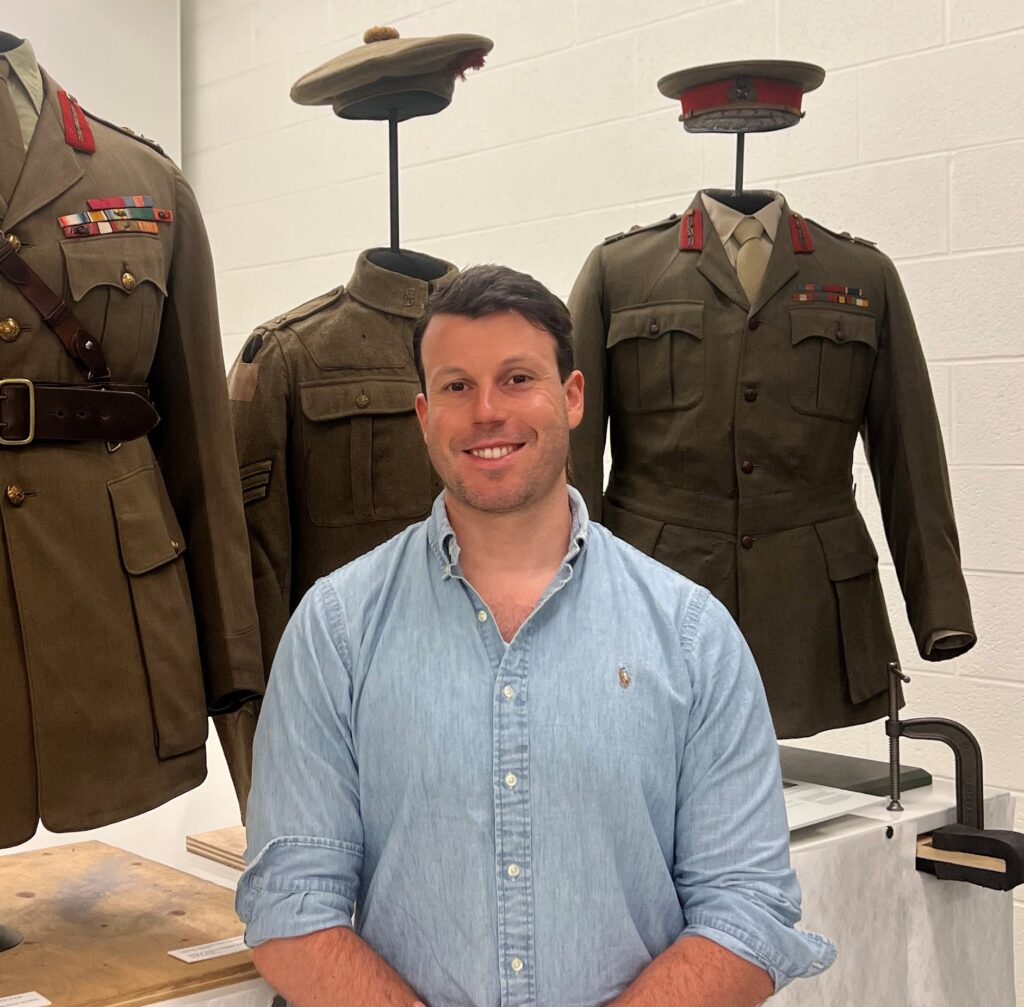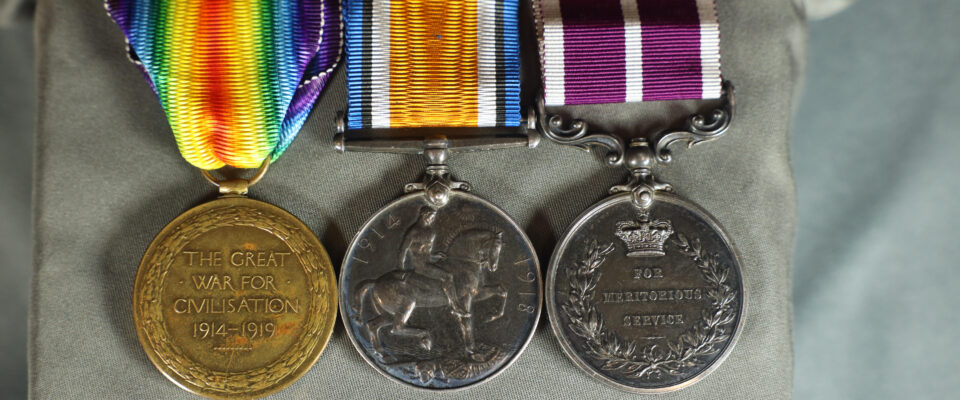We’re pleased to welcome our friends at the Royal Canadian Military Institute (RCMI) back for a follow-up blog post! RCMI recently acquired Sergeant Biggs’ original medals, which were mentioned in a previous article but not shown. Ryan Goldsworthy, RCMI Museum Director & Curator, has graciously provided an update is a military historian and material history expert from Toronto.
Revisiting Sergeant Biggs and the Canadian Railway Troops: The Exceptional Medal Set of a First World War Canadian Trainman
A Brief History of Canada’s First World War
The story of the Canadian Expeditionary Force (CEF) in the First World War (1914-1918) is an extraordinary one. Canada was a small nation of about 7 million people when the war began in August 1914 – Canada maintained only a small militia-based armed forces prior to then. The first Canadian contingent sent overseas, a single division, arrived in France by early-1915. Fighting without steel helmets or gas masks, the Canadian contingent fought gallantly at Ypres, Belgium in the face of gas warfare. Futile attacks at St. Eloi and Mont Sorrel followed as the Canadians learned how to wage warfare on the Western Front. By 1916, the Canadian Corps, the fighting arm of the CEF, had swelled to four oversized divisions and it had earned its first taste of battlefield victory near the small French town of Courcelette in late-September.
Seven months later, the Canadian Corps would achieve their most acclaimed victory at Vimy Ridge. Vimy was an undisputed victory for the Allies when such genuine triumphs were scarce in the early war years. Less than 50 years removed from Confederation, Vimy was perhaps the first time that Canada had made international headlines. By the fall of 1917, Canada had captured the remains of the Belgian town Passchendaele, which had cost the Corps some 16,000 casualties, but it had again proven the reliability and fighting resolve of the Canadian formation.
The victories at Vimy and Passchendaele served to bolster the reputation and resolve of the Canadian Corps and the Allied leadership would lean heavily on the small Canadian formation in the final push for victory in 1918. In the final Allied offensive of the war, the Hundred Days, Canada played a leading and disproportionately-sized role in bringing the war to a victorious close on 11 November 1918.
The Canadian Railway Troops
In this grand story of the CEF, the magnitude and importance of the logistical achievements must not be overlooked or downplayed. Indeed, the success at the “sharp end” and a healthy, robust supply line at the back end were inextricably linked. One major part of the Allied supply line was the many thousands of kilometers of railways built and maintained across the Western Front.
Formed in the spring of 1915 at the behest of the British Government, the first Canadian railway unit consisted of 500 selected men from the Canadian Pacific Railway. As the war progressed, there was a growing and desperate need for more trained railway personnel and, in 1916, the British War Office requested of Canada another railway unit of at least 1,000 men. The Canadians’ elite status for having experienced trainmen was a result of the massive pre-war railway projects constructed across Canada and tying the large Dominion together. Canada would therefore play a leading role in the construction and operation of railways on the war’s fighting fronts.

In the months before Vimy, monumental track building projects were undertaken to prepare for the battle. Now under the command of Canadian Brigadier-General Jack Stewart (the Deputy Director of General Transportation), five Canadian railway battalions were formalized, later followed by another five battalions and finally by an additional three before the end of the war, totaling 13. Following the victory at Vimy in April 1917, the Canadian Railway Troops (CRT) took responsibility for all light railways on the British front. This work amounted to a staggering 4,140 km of railway lines built and maintained from Vimy to the end of the war. By 1918, General Stewart commanded all British and Canadian railway units in France. Interestingly, in a rare case, the 2nd CRT Battalion would be used in an infantry role to defend against the German Spring Offensive of 1918.
Sergeant Biggs and the Meritorious Service Medal
One non-commissioned officer (NCO) of the CRT was a Sergeant William Thomas Biggs of Montreal who, like most Canadians in the railway troops, was an experienced pre-war trainman. Sergeant Biggs’ exquisite wartime uniform, badged to the 12th CRT Battalion, was detailed in my previous article for the Toronto Railway Museum of October 2022. Biggs’ uniform is an incredible piece of material history maintained by the RCMI, but I have since acquired his original medal set for the museum from the same donor, J. Victor Taboika. Like the uniform, the medal set remains in excellent condition.
Biggs’ medal set [pictured] contains three medals, in order – the Meritorious Service Medal (MSM), the British War Medal, and the Victory Medal. According to museum and collectors’ best practice, these medals will not be separated from each other and never will be. The value and provenance of the set is dependent on their completeness. The details on the rims of all three medals serve as the ultimate stroke of provenance. As was custom for the time, Biggs’ rank, name, regimental number, and regiment (CRT) are all inscribed on the medals’ rims. For identification and research, the unique regimental number is even more important than the name. There are several men by the name “William Biggs” in the CEF, but only one with the unique number seen on the medals. It is unfortunate that Canada did not similarly elect to individualize the service medals of the Second World War.

The British War and Victory Medals were often referred to as the medal pair or as “Mutt and Jeff,” two popular cartoon characters of the era. The British War Medal was awarded to Canadian (and commonwealth) military personnel of all ranks who served overseas between 5 August 1914 and 11 November 1918, or who had served in a theatre of war. Similarly, and most often awarded together, the Victory Medal was “awarded to all ranks of the fighting forces and to civilians under contract, and others employed with military hospitals who actually served on the establishment of a unit in a theatre of war” between the same dates as its paired medal (VAC 2022). Biggs’ MSM, of course, is the most special of his three. By the end of the Boer War (1902), the MSM was awarded to eligible commonwealth Warrant Officers and senior NCOs (Sergeant and above) who were discharged after at least 21 years of service (or 18 if disabled) and had earned the Long Service and Good Conduct Medal.

In 1916, however, the MSM was also awarded for cited acts of gallantry and all ranks were eligible to receive the medal. That the medal was eligible to all ranks was an uncommon condition amongst WWI gallantry awards (the Victoria Cross was the most prominent fellow exception). Indeed, because of the ribbon’s similarity in colour to the Victoria Cross’s, white stripes were added to the edges of the MSM’s ribbon in 1916 and a further white stripe was added to the centre in 1917. Biggs’ medal ribbon, awarded in 1918 for actions in 1917, can be seen with the three white stripes. The remaining details of the circular, silver medal (1.42 inches in diameter, the same size as the other two) include the effigy of King George V in a field marshal’s uniform on the obverse (front) and the inscription “For Meritorious Service” on the reverse.

The 1916 gallantry parameters for the award read as follows:
“Duly recommend for the grant in respect of gallant conduct in the performance of military duty otherwise than in action against the enemy, or in saving, or attempting to save the life of an officer or soldier, or for devotion to duty in a theatre of war.”
VAC 2022
The MSM’s gallantry condition was cancelled in 1928, but it was reinstated by the King’s Regulations and Orders’ of 1939, the start of the Second World War.
Biggs’ MSM was won for gallantry, one of only 1,430 awarded to Canadians during the First World War. Further details of Biggs’ citation can be found in the previous article, though it must be reemphasized that he exhibited great personal bravery which was far outside of his expected duties in the CRT. On 20 September 1917, with “utmost disregard for his own safety,” Biggs coordinated and performed efforts to suppress a large ammunition fire and prevent further exposures near an Allied railhead. It was his quick and decisive actions at the centre of these events which doubtlessly saved lives.
Biggs’ medal ultimately represents the very essence at the core of what made the CEF great – incredible acts of heroism by ordinary Canadians who were not professional soldiers before the war. There is a considerable impression from the Canadians who, despite having regular professions and lives, rose to the Herculean efforts required to carry the Allies into that ultimate victory against a formidable and militaristic enemy. The Prussians of the First World War were not the Nazis of the Second World War, but they illegally occupied much of Western Europe for 50 months under an often-brutal marital law.
On Remembrance Day, remember those ordinary Canadians, like William Biggs, who contributed and sacrificed to liberate & safeguard the sovereignty of Canada and its Allies.
-Ryan Goldsworthy

Sources and Further Reading
Goldsworthy, Ryan and Granatstein, J.L. “Canada’s Most Decisive Victory: An Analysis of Canada’s Role in the Hundred Days Offensive, 8 August – 11 November 1918.” Canadian Military History 32, 1 (2023)
Guay, David R.P. Tracks to the Trenches: Canadian Railway Troops in the Great War (1914-1919) (Markham, ON: Fifth House, 2017)
Nicholson, G.W.L. Canadian Expeditionary Force 1914-1919. Ottawa: Queen’s Printer, 1962.
Taboika, Victor. Military Antiques and Collectables of the Great War. Ottawa: Service Publications, 2007.
Veterans Affairs Canada, “British War Medal.” Last edited in May 2022: https://www.veterans.gc.ca/eng/remembrance/medals-decorations/details/8
Ibid, “Victory Medal (Inter-Allied War Medal),” Last edited in May 2022: https://www.veterans.gc.ca/eng/remembrance/medals-decorations/details/10
Ibid, “British Meritorious Service Medal,” Last edited in May 2022: https://www.veterans.gc.ca/eng/remembrance/medals-decorations/details/57
